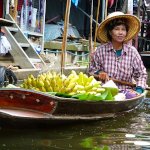National Canal Conservation Day in Thailand Date in the current year: September 20, 2025
 National Canal Conservation Day in Thailand is celebrated annually on September 20. It was established in 1995 to highlight the importance of khlongs (canals) as historical and cultural landmarks, as well as tourist sites.
National Canal Conservation Day in Thailand is celebrated annually on September 20. It was established in 1995 to highlight the importance of khlongs (canals) as historical and cultural landmarks, as well as tourist sites.The word “khlong” or “klong” is translated from Thai as “canal”. It can refer both to artificial canals of the Central Plains of Thailand and to smaller rivers, but most people associate khlongs with man-made canals. Canals in Thailand connect major rivers (such as the Chao Phraya, the Tha Chin, the Mae Klong) and their tributaries.
The system of canals in Thailand originated from moats that were dug to protect Thailand’s cites and towns. In 1782, King Rama I relocated the capital of Siam from Thonburi to Bangkok and ordered to dig a wide moat around the Grand Palace and link it with the Chao Phraya river with a canal, creating Rattanakosin Island.
By 1850, two more parallel canals had been dug, and by the end of the 19th century, Bangkok had become crisscrossed with numerous canals, which gained it the nickname “Venice of the East”. The system of larger and smaller khlongs that connected houses, temples and public spaces was used for transportation and floating markets, as well as for irrigation, drainage and natural cooling of buildings.
As European influence on Thailand increased in the late 19th and early 20th centuries, the canal-based transport system of Bangkok began to transform into a road-based one. Many khlongs were backfilled and turned into streets, but not all of them. The historic part of Bangkok has retained many of its khlongs that are considered living cultural and historical relics.
As of 2019, Bangkok had almost 1,700 canals, totaling over 2,600 kilometers in length. Most of them are located in the Thonburi area of Bangkok. Nine of Bangkok’s canals are primary flood drainage conduits. There are khlongs outside Bangkok, too: they connect rivers and their tributaries in central Thailand.
Although the remaining khlongs make it harder to expand the capital city since they complicate the construction of new roads and buildings, they are considered an integral part of the country’s culture and history, as well as an important tourist attraction. So the government of Thailand isn’t going to get rid of them anytime soon; moreover, National Canal Conservation Day was established to highlight their importance.
In addition to celebrating Thai canals, one of the key tasks of this day is to raise public awareness of the problem of canal pollution that has been growing over the past years. The polluted water of canals is a great medium for E. coli, Shigella, Salmonella and other pathogenic microbes that can cause serious diseases, not to mention that it smells awfully. Therefore National Canal Conservation Day is often marked with volunteer canal cleanups and environmental awareness campaigns.
- Category
- Ecological Observances
- Country
- Thailand